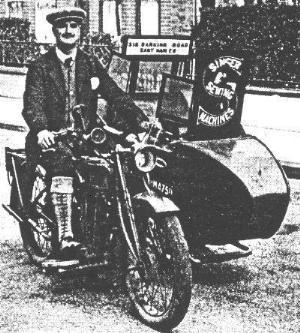Moving the Goods

The picture dates from 1919.
THIS TRUCK was used in Java to move crated Singers from the warehouse in a park to the city of Sourabaya.
From there the machines were sent to various towns on the island.

WITH THIS sidecar outfit (a BSA I think) William Dadd delivered Singer sewing machines from his shop in Barkng Road, East Ham, London, in the 1920s.
Our Bill was demobbed in 1921 and in his first year of business turned over 134 Singers.
By 1927 he had increased this to 118 machines plus £3,000 worth of accessories.
His reward for this was a decision from the Singer executives to cut the East Ham area in two, giving Dadd only half his previous catchment area.
He was told that with his enterprise he would soon build up business again!

WITH THE advent of the "sew by electricity" campaign by Singer in 1927, the company also updated most of its horse-and cart-transport to motor vans.
This picture shows William Thompson, a one-time cab driver, who started with Singer in 1891.
In 1927 he was promoted from horse-and-cart delivery, given a new uniform and this handsome motor van.

AS A DOG lover I'm not too sure that I approve of this system of hauling a cart as used by Singer's Gwent, Belgium, agent in the early 1920s.
The driver (?) obviously had to apply a little braking effect on down-hill stretches to avoid putting the cart before the dog, but what worries me is that he is not in a position to see the animal.
And how were turn commands given?

WE'VE OFTEN commented on the inventiveness and determination of Singer salesmen, but this example from Sweden in the 1920s takes some beating.
The Stockholm agent, faced with the problem of having many small islands as part of his territory, invented the floating shop which acted as a showroom, repair bay and even living and sleeping quarters for the salesman who would often be afloat for days at a time.






